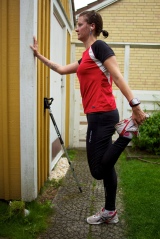Following Part 1 last week on pre-workout stretching, this post looks at post-workout stretching. Again, this routine assumes that you are a healthy, uninjured exerciser.
Post-workout is the time that you should be holding static stretches, and returning worked muscles to their pre-workout length, or even developing your flexibility for a greater range of motion. Your exercise session will have increased tension and tone through muscle contractions, so stretching will help to elongate muscles back to their original length, rather than maintaining the tension and stiffness in the hours following exercise.
Good flexibility is key to achieving a full range of motion in your exercise session, and good mobility in everyday life. The benefits include:
- Improved mobility and functionality in your daily movements,
- Increased effectiveness of workouts with full and complete movements,
- Increased strength gains,
- Reduced post-workout muscle soreness
- Improved posture and muscular balance, and
- Prevention of injuries (which hurt and stop workouts).
Stretching post-workout is a good time to develop your flexibility because your muscles will be warmed up, malleable and responsive to stretches. If you choose to stretch at any other time, be sure to do a warm-up first to get your heart-rate raised and your muscles warmed up.
| Here’s how to apply static stretching post-workout:The stretches: Just like with your dynamic warm-up, post workout stretches should focus on the muscles worked during your session. So, for example, focus on glutes, hamstrings and quads if you’ve been doing squats. Focus on pectorals and biceps if you’ve been doing pushups and chest presses. You can check out this video to get some ideas of stretches to do for pretty much any major muscle group worked.You can choose from two different types of static stretching:
1. Maintenance stretching will maintain the level of flexibility you have, returning your pumped muscles to their pre-workout length. To do this, slowly come into the stretch until you feel a bind in your muscle. This may be slightly uncomfortable, but should not hurt. If you feel pain, come gently out of the stretch until the pain subsides. Hold the stretch until you no longer feel the bind and move on to the other side or the next stretch. The length of hold will depend on your body and the level of workout you’ve completed, but is on 2. Developmental stretching will increase your flexibility and range of motion. To do this, follow the maintenance stretch above until the bind subsides, and then gently increase the stretch until you feel the bind again. Repeat this again (so that you have felt the bind three times) and then move on. |
And if you feel you really get into stretching and start feeling all the great benefits, why not try out a yoga or stretching class at your local gym or studio? Or check out a video from Youtube at home. This is a great 2-part full-body stretching session from the Fitnessista: Part 1 video, Part 2 video
Until next time!
Melissa





[…] 4. Stretch session: Remember to take a few minutes to stretch yourself out! […]
[…] You simply won’t achieve the same level of health or fitness without including resistance training in your programme. This applies to you no matter your age, fitness capacity or gender. Remember, a good fitness programme involves a healthy balance of cardio, resistance and flexibility (see stretching posts here and here). […]
[…] I escaped the rain and did a great full body compound workout at the gym. It involved a good warm-up on a machine (I like the fact they have a track on the screen), Pushups, Cable squats, Assisted pullups, Deadlifts, and Bent-over rows. I aimed for 4 sets of 8 reps of all exercises. I finished it off with a good stretch session. […]
[…] Warm-up and stretching: Like any workout activity, a good warm-up will help to get your body prepared for putting it to the test. You’ll want to focus on your shoulders, arms and core movements. Try doing some gentle shoulder rolls, arm circles, wall pushups (or tree push-ups!), row movements, side-to-side bends, and core twists as a warm up, slowly increasing intensity. As a general rule, any movements that mimic the activity you’ll be doing are a good way to warm up. Also, at the end of the session, try some upper body stretches, which may help to reduce stiffness and soreness in the next couple of days. For more on this topic, check out my posts on dynamic warm-ups and stretching. […]
[…] any interval training be sure to start with a dynamic warm up and end with a cool down stretch. The warm up is key so that your body is ready and able to work at a high level, and the cool down […]
[…] to the main event while doing actions similar to your exercise. Check out my posts on warm up and cool down stretch […]